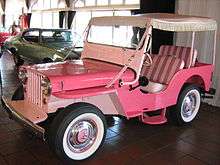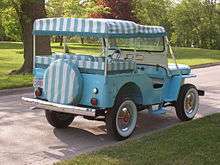Jeep DJ
| Jeep DJ | |
|---|---|
 | |
| Overview | |
| Manufacturer |
Willys Motors (1955–1962) Kaiser Jeep (1963–1970) American Motors (1970) AM General (1971–1984) |
| Also called | Mail Jeep |
| Production | 1955–1984 |
| Body and chassis | |
| Class | Truck |
| Body style | 3-door commercial vehicle |
| Layout | FR layout |
| Platform | Jeep CJ |
| Related | Jeep CJ |
| Powertrain | |
| Engine | Various |
| Transmission | Various manual and automatic |
| Dimensions | |
| Wheelbase | 80 in (2,032 mm) - Most |
| Curb weight | 3,400 lb (1,542 kg) |


The Dispatcher Jeep, or DJ, was a two-wheel-drive variant of the CJ series. Production started in 1955 by Willys which was renamed Kaiser Jeep in 1963. In 1970, American Motors (AMC) purchased Kaiser’s money-losing Jeep operations establishing AM General, a wholly owned subsidiary, that built this model through 1983. It was also the final light duty automobile to have front drum brakes.
DJ-3A
The DJ-3A was introduced in 1955. It used the body style of the older CJ-3A, along with the L-134 engine. Unlike the CJ-3A, it came with either a column shift or floor shift three-speed Borg-Warner T-96 manual transmission. It was offered with many different body options including a soft top, hard top, or even a full van body. One model was a postal delivery vehicle with the driver's position on the right side for mail box delivery[1]
In early 1959, Willys introduced the Jeep Gala to the export markets and uses desiring the nimble size and open bodywork, but no need for four wheel-drive.[2] This model gained popularity as a "fun car" at resorts in Hawaii, Mexico, and islands in the Caribbean area. It was finished in pink, green, or blue and trimmed with matching white striped fabric, as well as with fringe on its top.[2]
In fall of 1959, a similar model called the Jeep Surrey was introduced in the US market. The primary target market were resort hotels and vacation centers.[3] It also served as a low-cost rental vehicle for their guests. The Surrey came with a standard striped fabric top, as well as a matching fabric cover for what was advertised as a "Continental tire mount."[4]
DJ-5 and DJ-6
The DJ-3A was replaced by the right hand drive DJ-5 Dispatcher 100 in 1965. It was based on the CJ-5 and used the Hurricane and Dauntless engines. A 20-inch (508 mm) longer wheelbase DJ-6 model was built from 1965 to 1973 alongside the CJ-6.
DJ-5A through DJ-5M
The DJ-5A was introduced in 1967, beginning the lettering system indicating changes within the series.
The DJ-5A (Kaiser Co.) used a standard CJ front end, with a four-cylinder Chevrolet Nova 153 cu in (2.5 L) engine and two-speed Powerglide automatic transmission. In 1971, this was changed to a unique five-slot grille without turn signals that was used only on postal Jeeps. The 1971 model actually has the grille extend past the front of the hood edge. This allowed more room for the AMC Straight-6 engine and radiator. While resembling the CJ series, these were built as a completely enclosed, rear-wheel drive vehicle, with sliding doors (which could be opened while driving), and a swinging rear door. Most models only had the driver's seat and a mail tray where the second seat would normally be located. One improvement over earlier Jeeps was mounting the rear springs outside of the frame rails, thus providing greater stability for the vehicle with its top-heavy enclosed cargo area, especially at highway speeds. Most models were also equipped with a limited slip differential and a heavy-duty steering gearbox.
AM General used a variety of powerplants during production. DJ production was ended in 1984 with the DJ-5M, which used the 150 cu in (2.5 L) AMC Straight-4 engine.
DJ-5E Electruck
American Motors experimented with electric vehicles and starting in 1974 mass-produced the DJ-5E, a rear-wheel drive electric delivery van, also known as the Electruck.[5]
Similar in appearance and in most of its dimensions, the DJ-5E was powered by a set of two 27-volt lead-acid batteries with a 54-volt 30 bhp (22 kW; 30 PS) compound wound DC motor with electronic regulation made by Gould Electronics.[6] The U.S. Postal Service purchased 352 vehicles for the use in cities with serious air pollution.[7] The Electruck was capable of cruising at 33 mph (53 km/h) with a range of 29 mi (47 km) with 20% of its battery power still remaining in reserve.[7]
USPS logo and replacement
Although this vehicle was discontinued about ten years before the eagle logo for the United States Postal Service was changed (to a blue and white envelope-shaped bird head) some surviving DJs in the USPS fleet had the new logo on the doors.
The Wrangler Unlimited is currently available in right-hand drive for USPS delivery in rural areas of North America. These have replaced Jeep DJs for the USPS role.
Model numbers
- DJ-3A (1955–65): 134 cu in (2.2 L) Willys Go Devil straight-4 L-head engine, three-speed manual
- DJ-5 (1965–67): 134 cu in (2.2 L) Willys Hurricane straight-4 F-head engine, three-speed manual
- DJ-5A (1968–70): 153 cu in (2.5 L) Chevy Nova straight-4, two-speed Powerglide automatic
- DJ-5B (1970–72): 232 cu in (3.8 L) AMC Straight-6 engine, BorgWarner T-35 three-speed automatic
- DJ-5C (1973–74): 232 cu in (3.8 L) AMC Straight-6 engine, T-35 or M-11 automatic
- DJ-5D (1975–76): 232 cu in (3.8 L) AMC Straight-6 engine, 727 TorqueFlite automatic
- DJ-5E (1976): Electruck Electric
- DJ-5F (1977–78): 232 cu in (3.8 L) or 258 cu in (4.2 L) AMC Straight-6 engine, 727 TorqueFlite automatic
- DJ-5G (1979): AMC (Audi) 121 cu in (2.0 L) straight-4, 904 TorqueFlite automatic or 232 cu in (3.8 L) or 258 cu in (4.2 L) AMC Straight-6 engine, 727 TorqueFlite automatic
- DJ-5L (1982): GM Iron Duke engine 151 cu in (2.5 L) straight-4, Chrysler 904 transmission
- DJ-5M (1983–84): 150 cu in (2.5 L) AMC Straight-4 engine, Chrysler 904 transmission
References
- ↑ "Jeep For Mail Carriers Mounts Steering Wheel on Right Side." Popular Mechanics, March 1954, p. 154, bottom of page.
- 1 2 Statham, Steve (2002). Jeep Color History. MBI Publishing. p. 57. ISBN 978-0-7603-0636-9. Retrieved 12 November 2011.
- ↑ Foster, Patrick R. (2004). The Story of Jeep. Krause Publications. p. 102. ISBN 978-0-87349-735-0. Retrieved 12 November 2011.
- ↑ "Pink Jeep (advertisement)". The New Yorker. 35. 1959. Retrieved 12 November 2011.
- ↑ Committee on Appropriations; House of Representatives; Ninety-fifth Congress; second session (1978). Department of the Interior and related agencies appropriations for 1979. U.S. Government Printing Office. p. 343. Retrieved 26 December 2010.
- ↑ Automobile club d'Italia (1977). World Cars 1977. Herald Books. p. 34. ISBN 978-0-910714-09-9.
- 1 2 Hyde, Charles K. (2009). Storied Independent Automakers: Nash, Hudson, and American Motors. Wayne State University Press. p. 222. ISBN 978-0-8143-3446-1. Retrieved 26 December 2010.
External links
| Wikimedia Commons has media related to Jeep DJ. |
- Jeep DJ - Postal Jeep Facebook community
- Postal Jeep Homepage
- Jeep Engine Specs
- The Dispatcher Jeeps page
| Jeep road vehicle timeline, 1945–1970s — next » | |||||||||||||||||||||||||||||||||||
|---|---|---|---|---|---|---|---|---|---|---|---|---|---|---|---|---|---|---|---|---|---|---|---|---|---|---|---|---|---|---|---|---|---|---|---|
| Type | 1940s | 1950s | 1960s | 1970s | |||||||||||||||||||||||||||||||
| 5 | 6 | 7 | 8 | 9 | 0 | 1 | 2 | 3 | 4 | 5 | 6 | 7 | 8 | 9 | 0 | 1 | 2 | 3 | 4 | 5 | 6 | 7 | 8 | 9 | 0 | 1 | 2 | 3 | 4 | 5 | 6 | 7 | 8 | 9 | |
| Traditional | CJ-2A | CJ-3A | CJ-5 | ||||||||||||||||||||||||||||||||
| CJ-3B | CJ-7 | ||||||||||||||||||||||||||||||||||
| CJ-6 | |||||||||||||||||||||||||||||||||||
| Dispatcher | DJ-3A | DJ-5/6 | AM General | ||||||||||||||||||||||||||||||||
| Compact SUV | Jeepster (VJ) | Jeepster Commando | Commando | ||||||||||||||||||||||||||||||||
| SUV | Willys Jeep Station Wagon | Cherokee (SJ) | |||||||||||||||||||||||||||||||||
| Wagoneer (SJ) | |||||||||||||||||||||||||||||||||||
| Compact pickup | Jeepster Commando | Commando | |||||||||||||||||||||||||||||||||
| Full-size pickup | Willys Jeep Truck | ||||||||||||||||||||||||||||||||||
| Gladiator | J-Series | ||||||||||||||||||||||||||||||||||
| Truck | Forward Control | ||||||||||||||||||||||||||||||||||
| Van | FJ-3/3A | FJ-6/6A | |||||||||||||||||||||||||||||||||
| « previous — Jeep road vehicle timeline, 1980s–present | ||||||||||||||||||||||||||||||||||||||
|---|---|---|---|---|---|---|---|---|---|---|---|---|---|---|---|---|---|---|---|---|---|---|---|---|---|---|---|---|---|---|---|---|---|---|---|---|---|---|
| Type | 1980s | 1990s | 2000s | 2010s | ||||||||||||||||||||||||||||||||||
| 0 | 1 | 2 | 3 | 4 | 5 | 6 | 7 | 8 | 9 | 0 | 1 | 2 | 3 | 4 | 5 | 6 | 7 | 8 | 9 | 0 | 1 | 2 | 3 | 4 | 5 | 6 | 7 | 8 | 9 | 0 | 1 | 2 | 3 | 4 | 5 | 6 | ||
| Traditional | CJ-5 | |||||||||||||||||||||||||||||||||||||
| CJ-7 | Wrangler (YJ) | Wrangler (TJ) | Wrangler (JK) | |||||||||||||||||||||||||||||||||||
| Wrangler Unlimited (LJ) | Wrangler Unlimited (JK) | |||||||||||||||||||||||||||||||||||||
| Subcompact crossover | Renegade (BU) | |||||||||||||||||||||||||||||||||||||
| Compact crossover | Compass (MK) | |||||||||||||||||||||||||||||||||||||
| Patriot (MK) | ||||||||||||||||||||||||||||||||||||||
| Mid-size crossover | Cherokee (KL) | |||||||||||||||||||||||||||||||||||||
| Compact SUV | Cherokee/Wagoneer (XJ) | Liberty/Cherokee (KJ) | Liberty/Cherokee (KK) | |||||||||||||||||||||||||||||||||||
| Mid-size SUV | Grand Cherokee/Grand Wagoneer (ZJ) | Grand Cherokee (WJ) | Grand Cherokee (WK) | Grand Cherokee (WK2) | ||||||||||||||||||||||||||||||||||
| Commander (XK) | ||||||||||||||||||||||||||||||||||||||
| Full-size SUV | Cherokee (SJ) | |||||||||||||||||||||||||||||||||||||
| Wagoneer/Grand Wagoneer (SJ) | ||||||||||||||||||||||||||||||||||||||
| Compact pickup | CJ-8 (Scrambler) | Comanche (MJ) | ||||||||||||||||||||||||||||||||||||
| CJ-10 | ||||||||||||||||||||||||||||||||||||||
| Full-size pickup | J-Series | |||||||||||||||||||||||||||||||||||||